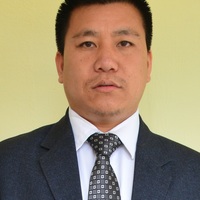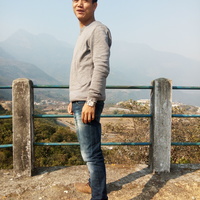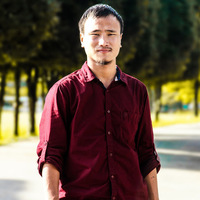
Dr. Tarh Ramya
B.A. (Hons.); PGDCA; M.A.; MPhil.; PhD
Supervisors: Prof. Sarit Kumar Chaudhuri
Address: Department of Tribal Studies, Arunachal Pradesh University, Hill Top, Pasighat - 791 103, East Siang District, Arunachal Pradesh, India.
Supervisors: Prof. Sarit Kumar Chaudhuri
Address: Department of Tribal Studies, Arunachal Pradesh University, Hill Top, Pasighat - 791 103, East Siang District, Arunachal Pradesh, India.
less
Related Authors
Bhaboklang Sohkhlet
Rajiv Gandhi University, Itanagar
ajanta das
Jawaharlal Nehru University
Alexander Aisher, PhD
University of Sussex
Nangram Nana
Rajiv Gandhi University, Itanagar
prem taba
Rajiv Gandhi University, Itanagar
InterestsView All (167)







Uploads
Papers by Dr. Tarh Ramya
community of Arunachal Pradesh by highlighting their indigenous knowledge of housing
patterns and food habits. A numerically weak community, Bangru is sited in about 15 villages
of Sarli circle in Kurung Kumey district, a northernmost frontier district bordering Tibet
(China) in the north-east Indian state of Arunachal Pradesh. According to the Electoral Rolls
conducted in 2011, the total population of Bangru was numbering about 1,023 (39.35%)
out of approximately 2,600 persons in the Sarli circle. Although there is no separate Census
record on this community, however, according to the data gathered, the Bangru account for
about 1.14% of the total population of Kurung Kumey district. The study was carried out
concerning three income groups. A total of 60 households (20 from each income group) were
assessed using different participatory appraisals through semi-structured questionnaires. A
special type of indigenous knowledge on housing pattern and food habit was explored in the
Bangru community, which correspond to the severe dependence on forest resources.
mainly in 15 Bangru villages of the Sarli circle of the Kurung Kumey district in Arunachal Pradesh.
Bangru language may be included in the Tibeto-Burman language family, though no evidence is available
on its language affiliation. It is different from the languages of Nyishi and Puroik tribes residing in the
same district, though they have social and cultural close affinities among them. However, while the Bangru
language has been largely influenced by the Nyishi and it is used very much a mixed form of speech at
present. But it would not be wrong to opine that the Bangru language is remarkably pure. Due to a
prolonged and intense language contact with the Nyishi and Puroik languages, Bangru reflects remarkable
changes in the linguistic structures. The status of the language shows serious signs of endangerment.
Materials and Methods: During the field study, the emphasis was laid on both participant and non-participant observation to examine their actual kinship terminology in use, kinship behaviours, etc. Extensive in-depth personal interviews and concrete case studies were taken to generate the desired mass of data. As a part of interview, the interview guide method was adopted to make the informants better understanding of the questions.
Results/Findings: The study reveals that in Bangru society, kinship terms do not have much distinction between terms of address and terms of reference. There are some terms like father– Mǝbi, mother– Aɲeya, grandfather– Mukho and grandmother– Asɛ which are used extensively both to address and reference.
Conclusion: The study assumes significance in the contemporary juncture as the use of kinship terms and behaviour are changing in the Bangru society. Most Bangru elders agree that the Bangru kinship system is the most important basic education for children. This understanding is a crucial part of the Bangru culture so as to gain a sense of who they are as Bangrus, and their relationships to their family members and relatives. Kinship is the Bangru heritage of relationships, respect, solidarity and mutual obligation in the family, clan and society.
makes any human society is its culture; a Latin word which was derived from
“colore” meaning to practice or cherish. For a society to be societal, it must be
cultural, therefore, society and culture are also intertwined. The culture of any society
is the way of life of its members; the collection of their ideas and habits which they
learn, share, and transmit from one generation to the other. In fact, culture is a
blueprint for living held by members of a particular society. Tribals are grossly
endowed with rich and unprecedented cultural values with which harmony, solidarity,
orderliness, sanctity and sanity are ensured within their community. Despite the fact
that there were no trained and armed security officers in the olden days as we have
today, yet their communities were void of chaos. In view of this, this paper is set to
examine some of these tribal cultural values and how the force of modernity has
influenced its observance with a particular reference to the Nyishi tribe of Arunachal
Pradesh. An attempt also will be made to discuss the concept of modernity and
equally on how tribal cultural values were enforced in the traditional societies. In
conclusion, recommendations will be made on the need to revive the tribal cultural
values as a panacea to the high level of moral decadence in the contemporary tribal
societies.
challenges are mainly concentrated in the rural areas of the state. The focal objective of this study is to examine the
challenges of rural development in Kurung Kumey district of Arunachal Pradesh. A total of 150 questionnaires
were administered to collect data from the residents of the district. Interviews were also conducted with office staff
in order to supplement the data from the questionnaire responses. It emerged from the study that development
challenges in Kurung Kumey district are multi-layered. These challenges range from poor transport services, poor
health facilities, poor educational facilities, limited electricity access, and shortage of markets for rural commodities.
Based on the findings, a number of recommendations were suggested to lessen the impact of the challenges.
community of Arunachal Pradesh by highlighting their indigenous knowledge of housing
patterns and food habits. A numerically weak community, Bangru is sited in about 15 villages
of Sarli circle in Kurung Kumey district, a northernmost frontier district bordering Tibet
(China) in the north-east Indian state of Arunachal Pradesh. According to the Electoral Rolls
conducted in 2011, the total population of Bangru was numbering about 1,023 (39.35%)
out of approximately 2,600 persons in the Sarli circle. Although there is no separate Census
record on this community, however, according to the data gathered, the Bangru account for
about 1.14% of the total population of Kurung Kumey district. The study was carried out
concerning three income groups. A total of 60 households (20 from each income group) were
assessed using different participatory appraisals through semi-structured questionnaires. A
special type of indigenous knowledge on housing pattern and food habit was explored in the
Bangru community, which correspond to the severe dependence on forest resources.
mainly in 15 Bangru villages of the Sarli circle of the Kurung Kumey district in Arunachal Pradesh.
Bangru language may be included in the Tibeto-Burman language family, though no evidence is available
on its language affiliation. It is different from the languages of Nyishi and Puroik tribes residing in the
same district, though they have social and cultural close affinities among them. However, while the Bangru
language has been largely influenced by the Nyishi and it is used very much a mixed form of speech at
present. But it would not be wrong to opine that the Bangru language is remarkably pure. Due to a
prolonged and intense language contact with the Nyishi and Puroik languages, Bangru reflects remarkable
changes in the linguistic structures. The status of the language shows serious signs of endangerment.
Materials and Methods: During the field study, the emphasis was laid on both participant and non-participant observation to examine their actual kinship terminology in use, kinship behaviours, etc. Extensive in-depth personal interviews and concrete case studies were taken to generate the desired mass of data. As a part of interview, the interview guide method was adopted to make the informants better understanding of the questions.
Results/Findings: The study reveals that in Bangru society, kinship terms do not have much distinction between terms of address and terms of reference. There are some terms like father– Mǝbi, mother– Aɲeya, grandfather– Mukho and grandmother– Asɛ which are used extensively both to address and reference.
Conclusion: The study assumes significance in the contemporary juncture as the use of kinship terms and behaviour are changing in the Bangru society. Most Bangru elders agree that the Bangru kinship system is the most important basic education for children. This understanding is a crucial part of the Bangru culture so as to gain a sense of who they are as Bangrus, and their relationships to their family members and relatives. Kinship is the Bangru heritage of relationships, respect, solidarity and mutual obligation in the family, clan and society.
makes any human society is its culture; a Latin word which was derived from
“colore” meaning to practice or cherish. For a society to be societal, it must be
cultural, therefore, society and culture are also intertwined. The culture of any society
is the way of life of its members; the collection of their ideas and habits which they
learn, share, and transmit from one generation to the other. In fact, culture is a
blueprint for living held by members of a particular society. Tribals are grossly
endowed with rich and unprecedented cultural values with which harmony, solidarity,
orderliness, sanctity and sanity are ensured within their community. Despite the fact
that there were no trained and armed security officers in the olden days as we have
today, yet their communities were void of chaos. In view of this, this paper is set to
examine some of these tribal cultural values and how the force of modernity has
influenced its observance with a particular reference to the Nyishi tribe of Arunachal
Pradesh. An attempt also will be made to discuss the concept of modernity and
equally on how tribal cultural values were enforced in the traditional societies. In
conclusion, recommendations will be made on the need to revive the tribal cultural
values as a panacea to the high level of moral decadence in the contemporary tribal
societies.
challenges are mainly concentrated in the rural areas of the state. The focal objective of this study is to examine the
challenges of rural development in Kurung Kumey district of Arunachal Pradesh. A total of 150 questionnaires
were administered to collect data from the residents of the district. Interviews were also conducted with office staff
in order to supplement the data from the questionnaire responses. It emerged from the study that development
challenges in Kurung Kumey district are multi-layered. These challenges range from poor transport services, poor
health facilities, poor educational facilities, limited electricity access, and shortage of markets for rural commodities.
Based on the findings, a number of recommendations were suggested to lessen the impact of the challenges.
seminar on Family and Clan in Tribal Societies of North East India jointly organised
by North Eastern Social Research Centre (NESRC), Guwahati, and Tribal
Study Centre (TSC), Eastern Theological Centre, Jorhat on 26-27 June 2014
at Guwahati, Assam. This compilation aims to capture the changes that are
taking place in family, clan, and social organisation in the tribal communities of
North East India from the perspective of native Christian scholars belonging
to various Christian denominations. Furthering its objectives, the book also
attempts to relook at the core values of traditional tribal worldviews that are
in tune with the Christian values while not losing sight of the newer realities.